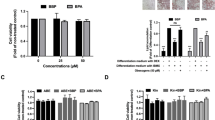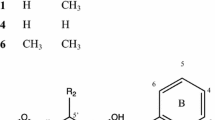Abstract
In this study, the inhibitory effects of bamboo leaf extracts on adipogenesis were investigated by evaluating their activity against adipogenic transcription factors and enzymes in 3T3-L1 adipocytes. Bamboo leaf extracts significantly decreased triglyceride levels, and increased glycerol release in adipocytes. Cells treated with the water extract showed significantly higher glycerol release as well as lower triglyceride contents than those treated with the ethanol extract. Both bamboo leaf extracts significantly inhibited the expression of adipogenic transcription factors and enzymes, such as CCAAT/enhancer-binding protein α, sterol regulatory element binding protein 1c, peroxisome proliferator-activated receptor γ, acetyl-coenzyme A carboxylase, and fatty acid synthase, and increased the expression of phospho-adenosine monophosphate-activated protein kinase. These results show that bamboo leaf extracts inhibited adipogenesis in 3T3-L1 adipocytes and that the water extract was more efficacious than the ethanol extract.






Similar content being viewed by others
References
Wu T, Guo Y, Liu R, Wang K, Zhang M. Black tea polyphenols and polysaccharides improve body composition, increase fecal fatty acid, and regulate fat metabolism in high-fat diet-induced obese rats. Food Funct. 7: 2469–2478 (2016)
Hsu CL, Yen GC. Effects of flavonoids and phenolic acids on the inhibition of adipogenesis in 3T3-L1 adipocytes. J. Agric. Food Chem. 55: 8404–8410 (2007)
Kopelman, PG. Obesity as a medical problem. Nature. 404: 635–643 (2000)
Bae CR, Park YK, Cha YS. Quercetin‐rich onion peel extract suppresses adipogenesis by down‐regulating adipogenic transcription factors and gene expression in 3T3‐L1 adipocytes. J. Sci. Food. Agric. 94: 2655–2660 (2014)
Fujioka S, Matsuzawa Y, Tokunaga K, Tarui S. Contribution of intra-abdominal fat accumulation to the impairment of glucose and lipid metabolism in human obesity. Metabolism. 36: 54–59 (1987)
Rosen ED, Walkey CJ, Puigserver P, Spiegelman BM. Transcriptional regulation of adipogenesis. Genes Dev. 14: 1293–1307 (2000)
Choi KM, Lee YS, Kim W, Kim SJ, Shin KO, Yu JY, Yoo HS. Sulforaphane attenuates obesity by inhibiting adipogenesis and activating the AMPK pathway in obese mice. J. Nutr. Biochem. 25: 201–207 (2014)
He YJ, Yue YD. A review of the effective component and applications of extracts from bamboo leaves. Biomass Chemical Engineering. 3: 008 (2000)
PARK EJ, JHON DY. The antioxidant, angiotensin converting enzyme inhibition activity, and phenolic compounds of bamboo shoot extracts. Food Science and Technology. 43: 655–659 (2010)
Koide CLK. The effect of bamboo extract on hepatic biotransforming enzymes–Findings from an obese–diabetic mouse model. J. ethnopharmacology. 133: 37–45 (2011)
Lara-Castro C, Fu Y, Chung BH, Garvey WT. Adiponectin and the metabolic syndrome: mechanisms mediating risk for metabolic and cardiovascular disease. Curr. Opin. Lipidol. 218.3: 263–270 (2007)
Lee MJ, Park WH, Song YS, Lee YW, Song YO, Moon GS. Effect of bamboo culm extract on oxidative stress and genetic expression: bamboo culm extract ameliorates cell adhesion molecule expression and NFκB activity through the suppression of the oxidative stress. Clin. Nutr. 2: 755–763 (2008)
Li X, Deng S, Fu H. Inhibition of the corrosion of steel in HCl, H 2 SO 4 solutions by bamboo leaf extract. Corrosion Science, 62, 163–175 (2012)
Choi S, Park MS, Lee YR, Lee, YC, Kim TW, Do SG, Jeon BH. A standardized bamboo leaf extract inhibits monocyte adhesion to endothelial cells by modulating vascular cell adhesion protein-1. Nutr. Res. Pract. 7: 9–14 (2013)
Shao D, Rangwala SM, Bailey ST, Krakow SL, Reginato MJ, Lazar MA. Interdomain communication regulating ligand binding by PPAR-γ. Nature. 396: 377–380 (1998)
Basu A, Sanchez K, Leyva MJ, Wu M, Betts NM, Aston CE, Lyons TJ. Green tea supplementation affects body weight, lipids, and lipid peroxidation in obese subjects with metabolic syndrome. J. Am. Coll. Nutr. 29: 31–40 (2010)
Kweon MH, Hwang HJ, Sung HC. Identification and antioxidant activity of novel chlorogenic acid derivatives from bamboo (Phyllostachys edulis). J Agric Food Chem. 49:4646–4655 (2001)
Park HS, Lim JH, Kim HJ, Choi HJ, Lee IS. Antioxidant flavone glycosides from the leaves of Sasa borealis. Arch Pharm Res. 30: 161–166 (2007)
Lam KY, Ling APK, Koh RY, Wong YP, Say YH. A review on medicinal properties of orientin. Adv Pharmacol Sci. 2016: 4104595 (2016)
Kim SH, Zhao X, Shen J, Chang KJ. Effects of phytosterols and fatty acids from lotus (Nelumbo Nucifera) seed on differentiation of human preadipocytes into adipocytes. The FASEB Journal. 27: 1079-30 (2013)
Ok E, Do GM, Lim Y, Park JE, Park YJ, Kwon O. Pomegranate vinegar attenuates adiposity in obese rats through coordinated control of AMPK signaling in the liver and adipose tissue. Lipids Health Dis. 12: 1 (2013)
Tontonoz P, Hu E, Spiegelman BM. Stimulation of adipogenesis in fibroblasts by PPARγ2, a lipid-activated transcription factor. Cell. 79: 1147–1156 (1994)
Rosen ED, Hsu CH, Wang X, Sakai S, Freeman MW, Gonzalez FJ, Spiegelman BM. C/EBPα induces adipogenesis through PPARγ: a unified pathway. Genes dev. 16: 22–26 (2002)
Wu Z, **e Y, Morrison RF, Bucher NL, Farmer SR. PPARg induces the insulin-dependent glucose transporter GLUT4 in the absence of C/EBPa during the conversion of 3T3 fibroblasts into adipocytes. J. Clin. Invest. 101: 22–32 (1998)
Spiegelman BM, Flier JS. Obesity and the regulation of energy balance. Cell. 104: 531–543 (2001)
Oh DR, Kim Y, Choi EJ, Jung MA, Bae D, Jo A, Kim S. Antiobesity effects of unripe rubus coreanus miquel and its constituents: An in vitro and in vivo characterization of the underlying mechanism. Evid. Based. Complement. Alternat. Med. 2016: 4357656 (2016)
Kwon TH, Wu YX, Kim JS, Woo JH, Park KT, Kwon OJ, Park NH. 6, 6′‐Bieckol inhibits adipocyte differentiation through downregulation of adipogenesis and lipogenesis in 3T3‐L1 cells. J. Sci. Food. Agric. 95: 1830–1837 (2015)
Kohjima M, Higuchi N, Kato M, Kotoh K, Yoshimoto T, Fu**o T, Takayanagi R. SREBP-1c, regulated by the insulin and AMPK signaling pathways, plays a role in nonalcoholic fatty liver disease. Int J Mol Med. 21: 507–512 (2008)
Min B., Lee H, Song JH, Han MJ, Chung J. Arctiin inhibits adipogenesis in 3T3-L1 cells and decreases adiposity and body weight in mice fed a high-fat diet. Nutrition research and practice. 8: 655–661 (2014)
Kersten S. Mechanisms of nutritional and hormonal regulation of lipogenesis. EMBO. Rep. 2: 282–286 (2001)
Zhang X, Koo J, Eun J. Antioxidant activities of methanol extracts and phenolic compounds in Asian pear at different stages of maturity. Food. Sci. Biotechnol. 15: 44 (2006)
Wu CH, Yang MY, Chan KC, Chung PJ, Ou TT, Wang CJ. Improvement in high-fat diet-induced obesity and body fat accumulation by a Nelumbo nucifera leaf flavonoid-rich extract in mice. J. Agric. Food. Chem. 58: 7075–7081 (2010)
Acknowledgements
This work was supported by a grant from the Korea Bio Medical Science Institute.
Author information
Authors and Affiliations
Corresponding author
Ethics declarations
Conflict of interest
The authors declare no conflict of interest.
Rights and permissions
About this article
Cite this article
Kwon, J.H., Hwang, S.Y. & Han, J.S. Bamboo (Phyllostachys bambusoides) leaf extracts inhibit adipogenesis by regulating adipogenic transcription factors and enzymes in 3T3-L1 adipocytes. Food Sci Biotechnol 26, 1037–1044 (2017). https://doi.org/10.1007/s10068-017-0150-y
Received:
Revised:
Accepted:
Published:
Issue Date:
DOI: https://doi.org/10.1007/s10068-017-0150-y




